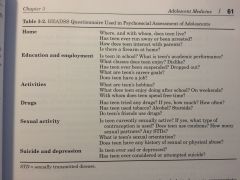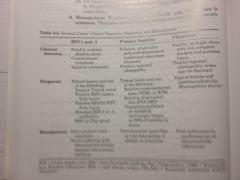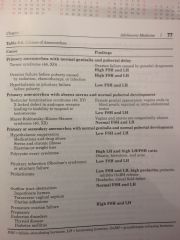![]()
![]()
![]()
Use LEFT and RIGHT arrow keys to navigate between flashcards;
Use UP and DOWN arrow keys to flip the card;
H to show hint;
A reads text to speech;
50 Cards in this Set
- Front
- Back
|
Male physical changes of puberty
- 1st sigh - Tanner stage (about the same for pubic female hair) |
1st sigh: testicular enlargement
Stage 1: no pubic hair, prepubertal testes Stage 2: sparse hiar, testes larger Stage 3: darker, coarser hair, testes enlarged Stage 4: glans develop, phair over symphysis Stage 5: hair to medial thigh |
|
|
Female puberty changes
- thelarche age - two things after thelarche |
- thelarche: breast buds 9.5 yo
- thelarche -> pubic hair --> menarche |
|
|
Tanner stage for breast development
|
Stage 1: preadolescent
Stage 2: elevaiion of breast, nipple as small projections Stage 3: breast enlargement, no separation of areola and breast Stage 4: areola and nipple for secondary mound Stage 5: only nipple projects |
|
|
Psychosocial development: early adolescence (10 - 13)
|
- shift to independence
- same-sex peer relationships - asbstract thinking - risk taking |
|
|
Psychosocial dev: middle adolescence (14- 17)
|
- incr conflicts with parents
- peer group involvment |
|
|
Psychosocial dev: late adolescence (18-21)
|
- dev of self as distinct
-- shared intimate relationship - fewer risk taking |
|
|
Psychosocial assessment: HEADSS
|

|
|
|
Immunization
|
1. Td booster (11-12 yo)
2. MMR, hep B if not give before 3. Varicella if not had chickenpox |
|
|
Lab for sexually active females
- males (2) |
1. cervical culture for N. gonorrhaeae
2. immunofluorescent/urine ligase for chlamydia trachomatis (males) 3. syphilis: serologic test (males) 4. PAP: for HPV cervical cancer 5. Trichomaonas vaginalis: vaginal wet |
|
|
Major depression definition
|
5/9 sx for every day for >2 weeks
- depressed mood - diminished interst - wt gain/loss - insomnia - fatigue - feeling of worthlessness - dim ability to concentrate - recurrent thoughts of death |
|
|
Dysthymic disorder
- definition |
2/5 sx for > 1year
- poor appetite or overeating - isonmnia - diminished energy - difficulty concentrating - feeling of hopelessness |
|
|
CAGE screen for alcholism
|
1. ever felt you had to cut down on drinking
2. people annoyed you by criticizing your drinking 3. ever felt guilty about drinking 4. every had drink first in morning (eye opener)? |
|
|
Risks associated smoking
|
- coronary artery disease/stroke
- cancers (lungs, mouth, larynk, stomach) - chronic lung dz, asthma - peptic ulcer disease - pregnancy complications |
|
|
Marijuana: physical effects
|
tachycardia
mydriasis hallucinations impaired cognition conjunctival erythema |
|
|
Obesity
- definition - health effects |
A. body weight 20% greater than ideal body weight
B. early pubertal dev hypertension, CV disease hypercholesterolemia DM, gallbaldder disease orthopedic problems |
|
|
Anorexia nervosa
- sx |
- 15% below ideal body weight
- fear of weight gain - absence of 3 consecutive menstrual cycles |
|
|
Contraceptive
A. male condom: adv B. female condom adv C. vaginal diaphragm adv/diadv D. cervical cap |
A. against STD (only latex)
B. into vaginal that protect against STD C. placed against cervix with spermicide but incr UTI D. placed over cervix but need to screen for papa smear for cerivcal dysplasia |
|
|
Intrauterine devices (IUD)
A types B mechanisms C disadv |
A. T38A copper bearing or progesterone-releasing
B. interfere with sperm transport/motility (copper) and induction of endometrial atrophy (progesterone) C. not against STD, PID, uterine bleeding |
|
|
Oral contraceptives
A. mechanisms B. adv C. contraindication |
A. inhibition of ovulation and thickening of cervical mucus
B. decr dysmenorrhea against endometrial + ovarian cancer improved acne C. breast/endometrial cancer stroke, coronary artery disease hypertension, diabetes, elevated lipids, smoking |
|
|
Contraceptive injections
A mehcanism B. adv C. disadv |
A. release of depo-provera
B. can used for 3 months C. not against STD |
|
|
Vaginitis
A. sexually transmitted kind B. types not sexually transmitted |
A. Trichomonas vaginalis
B. bacterial vaginosis candidal vulvovaginitis |
|
|
Trichomonas vaginalis
A. sx B. dx C. tx |
A. malodorous, yellow-green discharge
strawberry cervix, dyspareunia (pain during sex) B. wet mount saline microscopy, pH > 4.5 C. metronidazole (alcohol = vomiting) treat partner |
|
|
Bacterial vaginosis
A. etiology B. sx C. Dx D. tx |
A. Gardnerella vaginalis, Mycoplasma hominis
B. fishy, gray-white thin discharge little inflammation C. + "whiff test" for fishy odor + "clue cells" on saline microscopy pH > 4.5 D. metronidazole. partner no need for tx |
|
|
Candidal Vulvovaginitis
A. sx B. dx C. tx |
A. itching + white, curdlike discharge
vulvar + vaginal inflammation B. fungal hyphae, pH < 4.5 C. fluconazole |
|
|
Cervicitis
A. def B. etiology |
A. inflammation of mucous membrane sof endocervix
B. C. trachomatis N. gonorrhaeae HSV, syphilis |
|
|
C. trachomatis
A. sx B. dx C. complication D. tx |
A. purulent discharge, dysuria, urinary freq
B. culture, rapid fluorescent Ig, enzme immunoassay, PCR C. PID, tuboovarian abscess (TOA), ectopic preg, Fitz-Hugh-Curtis D. doxycycline, erythromycin, azithromycin |
|
|
N. gonorrhaeae
A. sx B. dx C. complication D. tx |
a. Mucopurulent discharge, dysuria, dysparenunia
B. culture, gram stain (gram -), PCR C. PID, TOA, neonatal conjunctivitis, Fitz-Hugh-Curtis D. ceftraiaxone |
|
|
Pelvic inflammatory disease
A. def B. dx + sx C. tx |
A. ascending infxn from cervix to uterus & fallopian tube
B. all: lower abdomen pain, cervical motion tenderness, bilateral adnexal tenderness one of: high WBC, CRP, ESR, fever, N. gonorrhaeae, C. trachomatis C. inpatient tx: clindamycin + gentamicin outpaitent tx: clindamycin or ceftraixone or doxycycline |
|
|
Urethritis
A. def B. etiology C. sx |
A. inflammation of urethra
B. N. gonorrheae, C. trachomatis, Ureaplasma, Mycoplasma gentialium, T. vaginalis, HSV C. Dysuria, incr urinary freq, mucopurulent urethral discharge |
|
|
Genital ulcer
- differentiate HSV 1/2, Treponema pallidum (syphilis), Haemophilus ducreyi (chancroid) |

|
|
|
Genital warts
A. etiology B. sx C. dx |
A. HPV (strain 16, 18)
B. itching, pain, dyspareunia if on external genitalia = condylomata acuminata C. pap smear |
|
|
Menstrual cycle phase: follicular (proliferative) phase
|
1. pulsatile release of GnRH (hypothalamus)
2. LH, FSH form pituitary 3. FSH --> maturation of ovarial follicles --> incr estradiol = endometrial thickening |
|
|
Menstrual Cycle: ovulation
|
1. LH release surge --> estradiol peak
2. folicle rupture --> corpus luteum |
|
|
Menstrual cycle: luteal (secretory) phase
|
1. progesterone produced by corpus luteum
2. CL involutes = decr progesterone and estradio 3. endometrial sloughing |
|
|
Dysmenorrhea
A. def B. types C. etiology D. tx |
A. pain associated with menstrual flow
B. primary = pain not assoc w/ pelvic abnormality secondary = apin asoc with pelvic abnormality C. primary by incr prostaglandin production D. prostaglandin inhibitors, oral contraceptives |
|
|
Amenorrhea
A. def B. types C. evaluation |
A. absence of mentrual flow
B. primary: absence by 16 + normal secondary sexual characteristic or absence by 14 w/o secondary sexual secondary: absence for 6 months after regular menstrual C. preg test TSH and thyroxine levels fasting prolactin high FSH, LH = ovarian failure --> turner syndrome? low FSH, LH = hypothalamic/pituitary failure |
|
|
Amenorrhea
A. etiology |

|
|
|
Abnormal vaginal bleeding
A. dysfunctional uterine bleeding B. polymenorrhea C. menorrhagia D. metrorrhagia E. menometrorrhagia F. oligomenorrhea |
A. freq, irregular, painless bleeding
B. regular intervals <21 days C. prolonged, excessive bleeding at regular interval D. bleeding at irregular interval E. excessive bleeding at irregular interval F. reglar interval but no more ofen than every 35 days |
|
|
Dysfunctional uterine bleeding
- etiology |
- endometrium thickened, unstable b/c unopposed estrogen
- ovulation not occur = no progesterone to stablize endometrium - bleeding b/c weaker-than-usual uterin contractions |
|
|
Abnoral vaginal bleeding
- etiology |
- infections
- pregnancy - blood dyscrasias: von Willebrand disease - cervical polyps |
|
|
Gynecomastia:
A. def B. differential |
A. glandular and stromal breast tissue
B. testicular tumors thyroid, liver disease usually normal |
|
|
Painful scrotal mass
- etiology |
- spermatic cord torsion
- testicular appendage torsion - epididymitis |
|
|
Painless scrotal mass
- etiology |
- testicular neoplasms
- indirect inguinal hernia - hydroceles - varicocele |
|
|
Torsion of spermatic cord
A. sx B. dx C. tx |
A. sudden onset, nausea, vomiting
swollen testicle absent cremasteric reflex on affect side B. decr uptake f radionuclide. absent pulsation on ultrasound C. detorsion within 6 hrs |
|
|
Torsion of testicular appendage
A. sx B. dx C. tx |
A. blue dot sign
B. doppler ultrasound, radionuclide scans normal C. rest |
|
|
Epididymitis
A. etiology B. sx C. dx |
A. N. gonorrhoeae, C. trachomatis
B. acute onset. swollen, tender epididymis C. ultrasound incr flow; radionuclide incr uptake |
|
|
Testicular neoplasm
A. sx B. dx |
A. firm, irregular, painless mass
B. chorionic gonadotropin, alpha-fetaprotein |
|
|
Indirect inguinal hernia
A. pathophysio B. sx |
A. proceessus vaginalis not obliterate = through internal inguinal ring
B. painless inguinal swelling |
|
|
Hydrocele
A. def B. sx C. dx |
A. fluid within tunica vaginalis
B. painless, soft, cystic scrotal mass C. transillumination of scrotum reveals cystic mass |
|
|
Varicocele
A. def B. sx |
A. dilation, tortuosity of veins in pampiniform plexus
B. left scrotum. bag of worms on palpation diminish when supin, enlarge with standing |

